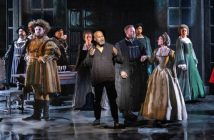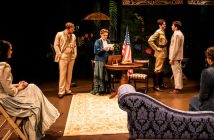Secrets are a recurring theme in Ibsen. And Solness, the ‘Master Builder’ of the title, has quite a few. Ralph Fiennes presents him in the opening scene as controlling, sardonic, casually cruel to those who work for him, manipulating them easily to fit his own plans. And fears. Because, despite appearances, the Master Builder does not have quite everything under control.
Take the fire at his wife’s grand family home. The Master Builder didn’t start the fire, but he had often considered the benefits such a fire would bring – he would be able to build many new houses on such a large site and establish himself as the main builder in town. Did thinking about such a fire actually cause it? Solness believes it did, that he has “helpers” – demons, maybe, or trolls since we’re in Norway – who put his thoughts into action. Outwardly controlling, maybe, but inwardly Solness is on the rack.

Fiennes captures this duality perfectly. He heartlessly manipulates the unfortunate Kaja, in love with him but engaged to his assistant, Ragnar, to keep Ragnar working for him so he cannot become the competition. For Solness fears the young, too, and the threat they pose when they come knocking at his door. Above all, though, he fears madness.
All these fears spill out when Solness’s friend, Doctor Herdal, visits. The calm, sardonic mask falls to reveal a man tormented by guilt and the fear that he is indeed mad. Into this scene, steps Hilde (Sarah Snook), a golden Viking complete with knapsack and alpenstock, fresh from the mountains. Solness does not remember her at all so Hilde recounts the day that, she says, changed her life when she was just 12: the day the Master Builder came to their little town to put the wreath around the top of the spire of the new church he had built. Later, he came to her house and said she was surely a princess who warranted a castle and her own kingdom. Solness would build the castle for her and would come for her in 10 years time. The 10 years were now up and she had come to him.

Solness has no recollection of any of this later part of her story and at first thinks she is teasing him – or perhaps she dreamt the whole thing (Hilde has already admitted to having vivid dreams). Somehow, though, he decides to accept the story, at first as a game but then gradually, visibly, he becomes entranced by her and the dark, tormented, sardonic figure transforms yet again. This is a new Solness – eager, full of ideas, not fearful at all. When the young come knocking at the door, says Hilde, you should let them in. Solness has. Hilde has come to stay.
Mrs Solness – Linda Emond, a powerfully still centre in this reeling play – takes it all in her stride and puts Hilde in the middle nursery. Aline Solness lost her twin boys as babies, soon after the fire, when her resulting fever had infected her milk. The nurseries have remained empty ever since. This secret sorrow is visible in her every fibre as she sleepwalks through a life devoted now to duty.

By the second act, under the influence of Hilde Solness has shape-shifted again into a febrile, potent version of the Master Builder – as Hilde always addresses him, never by name. She has created a version of him that gives him almost godlike power. They plan her castle as the next building project – “a castle in the air” says Hilde, “with strong foundations”, says Solness. The heady mix of potency – “If only we could be Vikings” – creativity and sexuality infuses Solness with the feeling that he is perhaps as invincible as Hilde thinks him and he can overcome one last fear – vertigo. Hilde persuades him to place a garland on the spire of the house he has just built for Aline and himself. Solness climbs to the top of the scaffold – and falls to his death.
This is a superb production. The background set of wood piled up like old bones comes tumbling down at the end with Solness – a life without strong foundations, after all. It’s a play that keeps you guessing, too. Is Hilde a fantasist? Is she as much a manipulator as Solness himself? Is she, even, one of Solness’s demons, as much his salvation? Norwegian trolls are not just the short ugly ones with bludgeons we picture. The myths had another version – beautiful girls like Sirens who lure you to your ruin. Snook certainly looks that part and there’s definitely an on-stage chemistry with Fiennes though her most affecting scene was a short one with Aline Solness. And Fiennes? Just magnificent.
The Master Builder at the Old Vic Theatre, until 19th March 2016. Running time approximately 2hrs 45mins including two 20-minute intervals. For more information and tickets visit the website.




